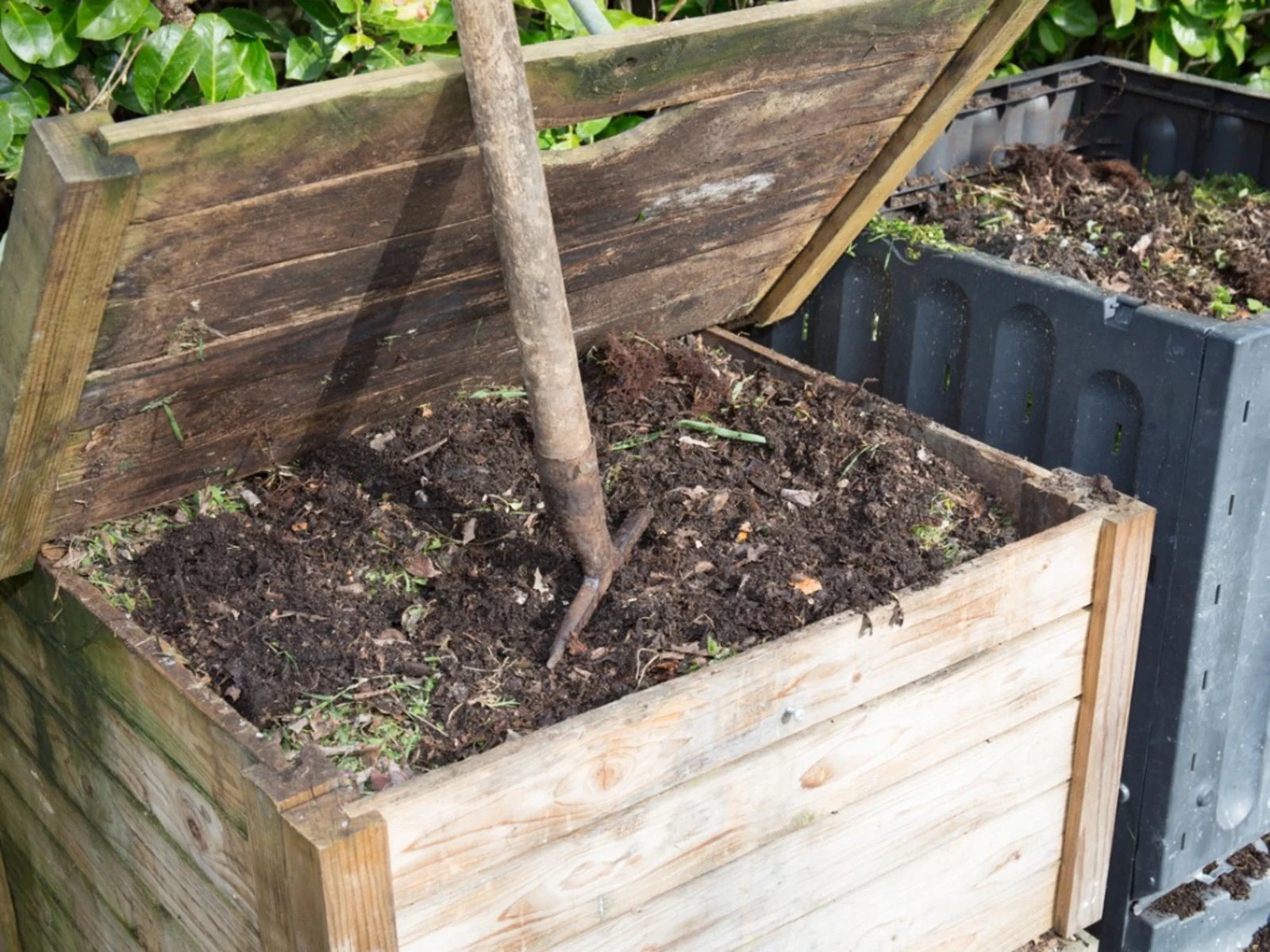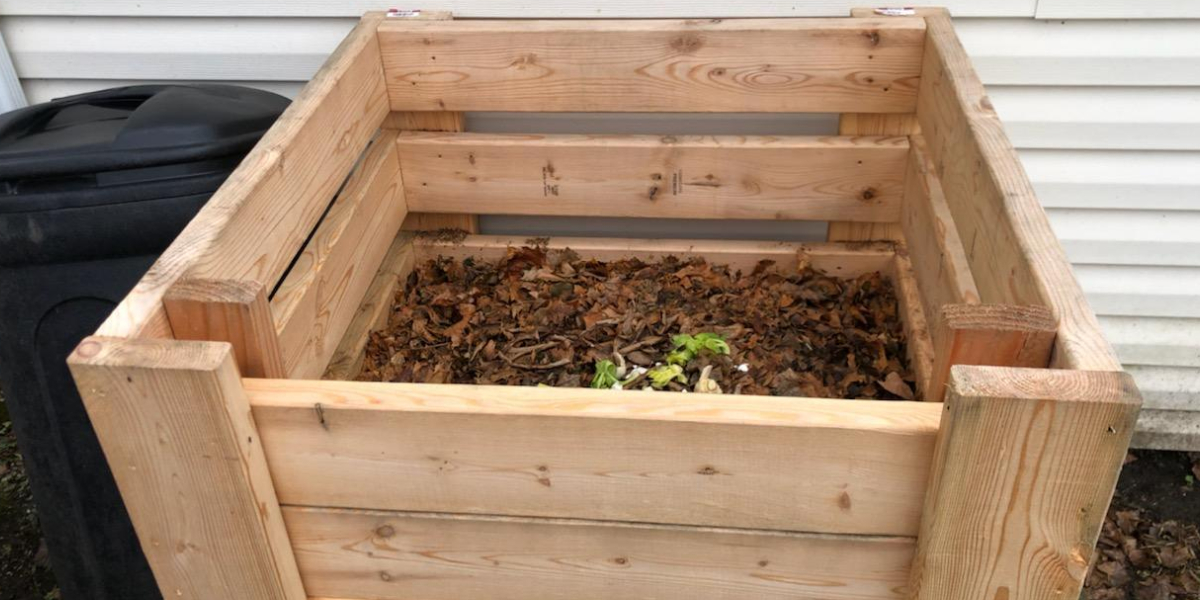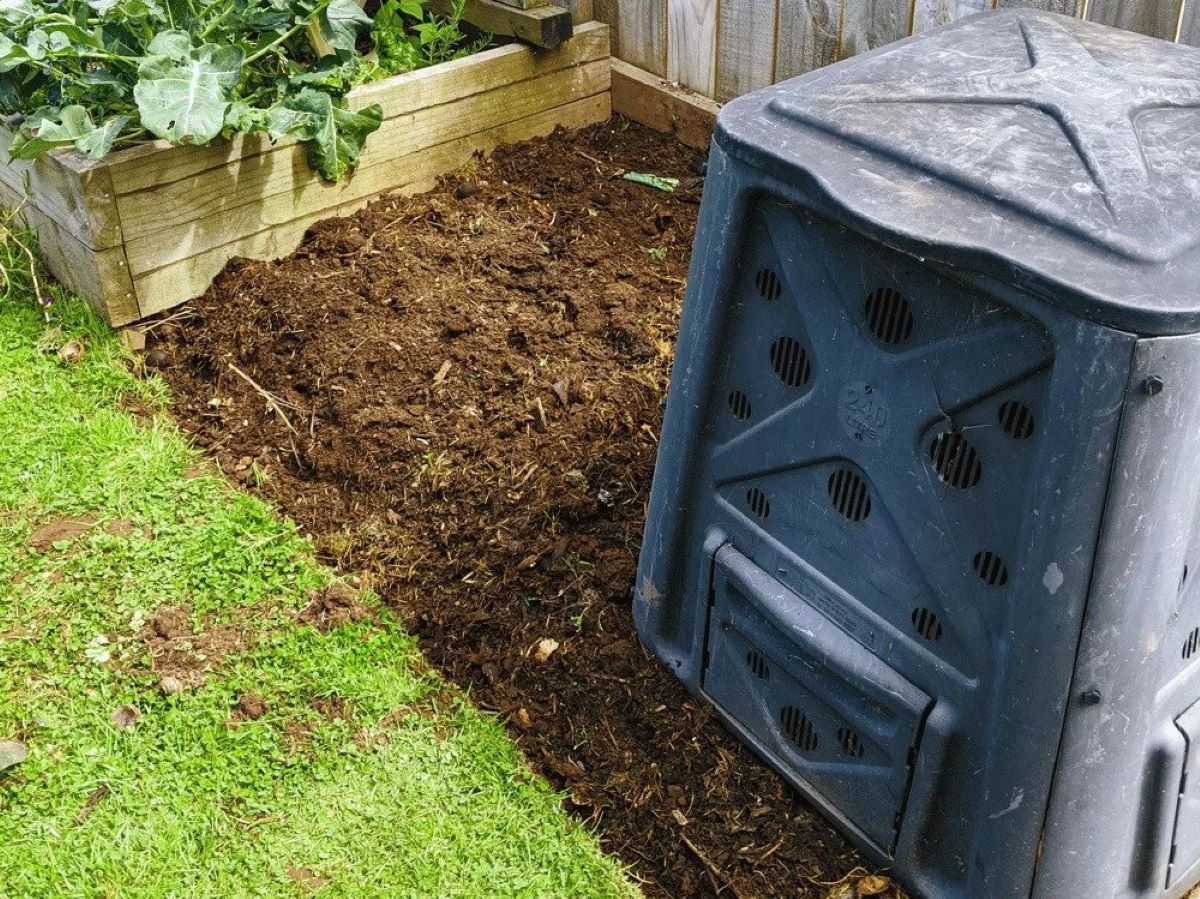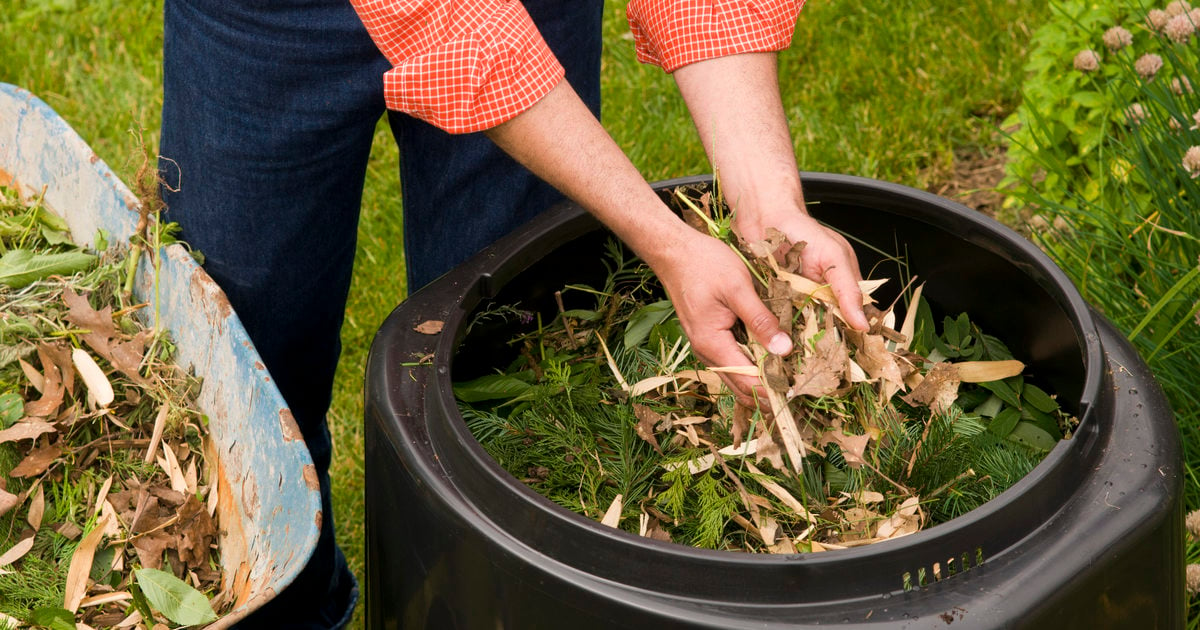Home>Gardening Tips and Tricks>Eco-Friendly Gardening>What Goes In Compost Bin


Eco-Friendly Gardening
What Goes In Compost Bin
Modified: February 9, 2024
Learn how to create an eco-friendly compost bin for your garden with our comprehensive guide. Start composting and reduce waste while nourishing your plants.
(Many of the links in this article redirect to a specific reviewed product. Your purchase of these products through affiliate links helps to generate commission for Chicagolandgardening.com, at no extra cost. Learn more)
Table of Contents
Introduction
Composting is a key practice in eco-friendly gardening that not only helps reduce waste but also enriches the soil and promotes sustainable plant growth. Whether you have a sprawling garden or a small urban balcony, composting allows you to contribute to a healthier environment while reaping the benefits of nutrient-rich soil for your plants.
The process of composting involves converting organic materials, such as kitchen scraps and yard waste, into a dark, crumbly substance known as compost. This natural fertilizer provides essential nutrients and improves the structure of the soil, resulting in healthier plants with increased resistance to pests and diseases.
Composting is a simple and cost-effective way to reduce the amount of waste that enters landfills. By diverting organic material from the trash, we can significantly decrease harmful methane gas emissions that contribute to climate change. Additionally, composting helps to conserve water by improving soil moisture retention and reducing the need for irrigation.
In this article, we will explore the ins and outs of composting and how you can incorporate this eco-friendly practice into your gardening routine. From what materials can be composted to the do’s and don’ts of composting, we will provide you with all the information you need to get started on your own composting journey.
Importance of Composting
Composting plays a crucial role in promoting sustainable gardening practices and preserving the environment. Let’s explore the key reasons why composting is so important:
1. Reduce waste: Composting allows us to divert a significant amount of organic waste from landfills. Instead of letting kitchen scraps and yard trimmings end up in the trash, we can turn them into valuable compost that nourishes our soil and plants.
2. Enrich the soil: Compost is a nutrient-rich soil amendment. When added to garden beds or potted plants, it improves soil structure, enhances its ability to hold water, and provides essential nutrients for plant growth. This results in healthier, more vibrant plants that are better equipped to withstand pests and diseases.
3. Conserve water: Compost helps the soil retain moisture by improving its water-holding capacity. This means you’ll need to water your plants less frequently, reducing water consumption in your garden. Furthermore, compost aids in preventing soil erosion, ensuring that water remains in the root zone and is utilized efficiently by plants.
4. Boost plant health and productivity: The organic matter in compost acts as a slow-release fertilizer, providing a steady supply of nutrients to plants over time. This leads to stronger root development, improved nutrient uptake, and increased plant productivity. Compost also enhances soil’s ability to support beneficial microorganisms, which further aids in plant growth.
5. Enhance biodiversity: Composting supports a healthy ecosystem in your garden by attracting beneficial insects and microorganisms. These organisms contribute to natural pest control, improve soil fertility, and create a balanced ecosystem where plants can thrive.
6. Reduce greenhouse gas emissions: When organic waste breaks down in landfills, it produces methane, a potent greenhouse gas. By composting, we can reduce these methane emissions and contribute to mitigating climate change.
7. Promote sustainable gardening practices: Composting is an essential component of sustainable gardening. By incorporating this practice into your gardening routine, you are actively participating in eco-friendly habits that support the health of our planet.
By composting, we can make a positive impact on the environment while simultaneously reaping the benefits of healthier soil and more productive plants. Now that we understand the importance of composting, let’s delve into which materials can be composted to create nutrient-rich soil amendment.
What Can Be Composted
Composting is a versatile process that allows for the breakdown of a wide range of organic materials. To achieve a successful compost pile, it’s important to balance the ingredients and incorporate a mix of “greens” and “browns.
- Greens: Greens are materials that are rich in nitrogen, providing the necessary protein for microorganisms to break down organic matter. Common green materials include:
- Vegetable and fruit scraps
- Coffee grounds and filters
- Grass clippings (without herbicides)
- Green leaves and plant trimmings
- Tea bags (remove any metallic staples)
- Browns: Browns are high in carbon and help create airflow in the compost pile. They balance the high nitrogen content of greens and include:
- Dry leaves
- Shredded newspaper (avoid glossy paper)
- Cardboard (free of tape, stickers, and plastic)
- Straw or hay
- Wood chips or sawdust
It’s important to avoid composting items that can cause issues or contaminate the compost. These include:
- Meat, dairy, or greasy foods (they can attract pests and have a longer decomposition time)
- Animal waste
- Coal or charcoal ash
- Diseased plants
- Plastic, glass, or metal
- Weeds with seeds or invasive plant species
- Chemically-treated wood or sawdust
Remember that a successful compost pile requires both greens and browns and should be layered to promote proper decomposition. Aim for a ratio of roughly 3 parts browns to 1 part greens by volume. Additionally, it’s important to regularly turn the pile to provide oxygen and ensure an even breakdown of materials.
Now that we know what can be composted, let’s dive into the do’s and don’ts of composting to ensure optimal results for your compost pile.
Greens
Greens, also known as nitrogen-rich materials, are a vital component of successful composting. They provide essential nutrients and moisture to help break down organic matter effectively. Here are some common examples of greens that can be added to your compost pile:
- Vegetable and fruit scraps: Include peels, cores, and scraps from a variety of fruits and vegetables. Avoid adding any spoiled or moldy produce, as it can attract pests.
- Coffee grounds and filters: Used coffee grounds are an excellent source of nitrogen and can be added to your compost. Make sure to remove any plastic or metal components from coffee filters before composting.
- Grass clippings (without herbicides): Fresh grass clippings are high in nitrogen and add moisture to the compost pile. However, be cautious if you have used herbicides on your lawn, as these chemicals can negatively affect the composting process.
- Green leaves and plant trimmings: Any green plant material, such as leaves, small branches, or plant trimmings, can be added to the compost pile. Chop them into small pieces to speed up the decomposition process.
- Tea bags: Used tea bags can be added to the compost pile, but be sure to remove any metallic staples. Tea leaves are a great source of nitrogen and can enrich the nutrient content of your compost.
When adding greens to your compost pile, it’s important to maintain a balance with “browns” – carbon-rich materials – to facilitate proper decomposition. Too much nitrogen-rich material can result in a smelly, slimy compost pile. Aim for a ratio of approximately 1 part greens to 3 parts browns to maintain a healthy composting environment.
To enhance the decomposition process, chop or shred your green materials into smaller pieces. This increases the surface area, allowing microorganisms to break them down more efficiently. It’s also important to layer the greens within the compost pile rather than placing them in a single clump. This helps to ensure even distribution and proper oxygen flow.
Remember to water the compost pile periodically, especially if the greens added are dry. This helps to maintain the optimal moisture level for decomposition. Too much or too little moisture can hinder the composting process, so aim for a moist but not saturated consistency.
By including a healthy mix of greens while composting, you are not only diverting waste from landfills but also creating nutrient-rich compost that will nourish your plants and promote a flourishing garden.
Browns
Browns, also known as carbon-rich materials, are an essential component of composting. They provide structure, absorb moisture, and create airflow within the compost pile. Incorporating a balanced mix of browns along with greens helps create a healthy and productive composting process. Let’s explore some common examples of browns:
- Dry leaves: Fallen leaves are a readily available source of carbon. Collect them in the fall and use them throughout the year for your compost pile. Shred or break them into smaller pieces to speed up decomposition.
- Shredded newspaper: Newspaper can be an excellent source of carbon. Tear it into small strips or shred it before adding it to the compost pile. Avoid using glossy or colored sections, as they may contain chemicals that are harmful to the soil and plants.
- Cardboard: Unprinted and untreated cardboard, such as cardboard boxes, can be a great source of carbon. Tear the cardboard into small pieces and add it to the compost pile, making sure to remove any tape, stickers, or plastic materials.
- Straw or hay: Straw or hay can be used as a brown material in composting. These materials provide structure and help create air pockets within the pile. Make sure they are free of pesticides or herbicides that could potentially harm your plants.
- Wood chips or sawdust: Small amounts of untreated wood chips or sawdust can be added to the compost pile. However, avoid using large quantities as wood takes longer to break down and can affect the carbon-to-nitrogen ratio.
While adding browns to the compost pile, remember to maintain a proper balance with greens. Aim for a ratio of roughly 3 parts browns to 1 part greens by volume. This ratio provides optimum conditions for microorganisms to break down the organic matter effectively.
Layering the browns throughout the compost pile helps create a well-mixed and well-aerated environment. Avoid placing a thick layer of browns on top or bottom of the pile, as it may hinder proper airflow and slow down decomposition. Instead, alternate layers of greens and browns to ensure even distribution of materials.
It’s important to note that browns decompose at a slower rate compared to greens. Patience is key! It may take a bit longer for the browns to break down, but they provide long-term benefits to the soil structure and nutrient composition.
By including a balanced mix of browns in your composting process, you are enhancing the decomposition rate, improving the quality of your compost, and contributing to a healthier and more sustainable gardening practice.
Do’s and Don’ts of Composting
Composting is a straightforward process, but there are a few key do’s and don’ts to keep in mind to ensure successful and efficient composting. Let’s explore some important guidelines:
Do’s of Composting:
- Do compost a variety of organic materials: Include a diverse range of kitchen scraps, yard trimmings, and other organic matter to create a nutrient-rich compost. This helps maintain a healthy balance of nutrients in the soil.
- Do maintain the proper carbon-to-nitrogen ratio: Aim for a balanced mix of browns and greens to create an optimal environment for decomposition. A ratio of 3 parts browns to 1 part greens by volume is generally recommended.
- Do turn the compost pile regularly: Turning the pile every few weeks helps distribute oxygen and promotes even decomposition. This process also prevents the pile from becoming compacted and assists in avoiding unpleasant odors.
- Do keep the compost pile moist: Maintain a moist but not saturated environment within the compost pile. Regularly water the pile, especially during dry periods, to ensure proper decomposition and microbial activity.
- Do chop or shred materials: Cutting or shredding larger materials into smaller pieces increases the surface area, promoting faster decomposition and accelerating the composting process.
Don’ts of Composting:
- Don’t include meat, dairy, or greasy foods: These items can attract pests and produce odors. Avoid adding meat, bones, fish, dairy products, or oily foods to your compost pile.
- Don’t compost weed seeds or invasive plants: Some weeds and invasive plant species may survive the composting process and end up spreading in your garden. It’s best to dispose of these plants in a different manner.
- Don’t add diseased plants: Plants infected with diseases or pests should not be composted, as the heat generated during composting may not be sufficient to kill pathogens. Dispose of diseased plants separately to prevent the spread of diseases.
- Don’t use chemically-treated materials: Avoid composting materials treated with pesticides, herbicides, or any other chemicals. These substances can harm beneficial microorganisms and potentially contaminate your compost and soil.
- Don’t neglect aeration: Proper airflow is crucial for composting. Avoid compacting the pile and ensure there is enough space for oxygen circulation. This can be achieved by turning the pile regularly or using a compost bin with adequate ventilation.
By following these do’s and don’ts of composting, you can create a healthy and productive compost pile. Remember to be mindful of the materials you include, maintain the right balance, and provide proper moisture and aeration. With time and patience, you’ll soon have nutrient-rich compost to nourish your garden plants and promote a thriving ecosystem.
Composting Process
The composting process involves a series of natural biological reactions that break down organic materials into nutrient-rich compost. Understanding the steps involved in composting can help you optimize the process and achieve quality compost for your gardening needs. Let’s explore the composting process in detail:
1. Gather materials:
Collect a mix of greens (nitrogen-rich materials) and browns (carbon-rich materials) to create a balanced compost pile. Remember to include a variety of organic waste, such as kitchen scraps, yard trimmings, and dry leaves, to supply the necessary nutrients for microorganisms.
2. Prepare the compost pile or bin:
Choose an appropriate location for your compost pile or bin. It should be well-drained and receive partial sunlight. If using a bin, ensure it has proper aeration and drainage. Layer the greens and browns in the compost pile, starting with a layer of browns, followed by greens, and continue this alternating pattern. Moisten the pile until it feels like a damp sponge.
3. Turn the compost pile:
Regularly turning the compost pile is essential to provide oxygen and aid decomposition. Use a pitchfork or shovel to mix the materials thoroughly. Turning the pile once every few weeks helps distribute heat, moisture, and microbes evenly, promoting faster breakdown.
4. Maintain moisture levels:
Ensure that the compost pile remains moist but not overly saturated. Water the pile regularly, especially during dry periods, to keep the materials adequately damp. A dry compost pile slows down decomposition, while excessive moisture can lead to a smelly, anaerobic environment. Adjust the moisture level as needed to provide optimal conditions for microbial activity.
5. Monitor and adjust the compost pile:
Regularly monitor the compost pile for temperature, smell, and moisture. As the decomposition process progresses, the pile will generate heat, reaching temperatures between 110-160°F (43-71°C). If the pile becomes too hot or starts to emit a foul odor, it may indicate an imbalance of materials or insufficient aeration. Adjust the compost pile by adding more browns or turning the pile more frequently to correct the conditions.
6. Wait for the compost to mature:
Composting takes time, and the duration can vary depending on factors such as the materials used, environmental conditions, and management practices. Generally, composting can take anywhere from a few months to a year to reach maturity. The finished compost will be dark, crumbly, and have a pleasant earthy smell.
7. Use the compost:
Once the compost has matured, it is ready to be used in your garden. Apply the compost as a top dressing in garden beds, mix it with potting soil for container plants, or use it as a nutrient-rich mulch. The compost will improve soil structure, fertility, and water-holding capacity, benefiting your plants’ overall health and productivity.
By following the composting process, you can turn organic waste into valuable compost, reducing landfill waste and nourishing your garden in an environmentally friendly way. Patience and proper management will yield quality compost for years to come.
Maintaining the Compost Bin
Maintaining your compost bin is essential to ensure a successful composting process and achieve high-quality compost. Regular maintenance helps optimize the environment for decomposition and prevents potential issues. Here are some key practices for maintaining your compost bin:
1. Turning the compost:
Regularly turning the compost pile or bin helps mix the materials, provide oxygen, and distribute moisture evenly. Turning the pile every few weeks using a pitchfork or shovel accelerates the decomposition process and prevents the formation of anaerobic conditions. This promotes the growth of beneficial microorganisms and ensures the breakdown of organic matter.
2. Monitoring moisture levels:
Proper moisture is crucial for composting. The compost pile should be damp, similar to a wrung-out sponge. If the pile becomes too dry, decomposition slows down. Conversely, if it is too wet, it may become compacted and emit a foul odor. Regularly check the moisture levels and adjust by adding water or dry materials (such as dry leaves) to maintain the ideal moisture balance.
3. Adding additional materials:
As you accumulate kitchen scraps and yard waste, regularly add them to the compost bin. Continuously incorporating a mixture of greens (nitrogen-rich materials) and browns (carbon-rich materials) maintains the ideal carbon-to-nitrogen ratio and ensures a balanced composting environment. Aim for a mix of roughly 3 parts browns to 1 part greens to promote efficient decomposition.
4. Managing pests:
Pests such as fruit flies, ants, or rodents may be attracted to your compost bin. To deter these pests, bury food scraps beneath a layer of browns or cover the compost pile with a breathable material such as a mesh screen. Avoid adding meat, dairy, or greasy foods that are more likely to attract pests. If you encounter persistent pest issues, consider placing a hardware cloth at the bottom of your compost bin to prevent rodents from accessing it.
5. Controlling odor:
An unpleasant odor in your compost bin can indicate an imbalance of materials or inadequate aeration. Mix in browns such as dry leaves or shredded newspaper to absorb excess moisture and help combat odor. Additionally, make sure the pile is properly turned and aerated to promote proper decomposition and reduce the risk of foul smells.
6. Harvesting the compost:
Once the compost has fully decomposed and reached a dark, crumbly consistency, it is ready to be harvested. You can do this by either removing the compost from the bottom of the bin or using a compost tumbler by rotating it to empty the fully processed compost. The remaining compost can be used in your garden to nourish plants and improve soil fertility.
By maintaining your compost bin properly, you create an optimal environment for decomposition, limit potential issues, and ensure the production of high-quality compost. Regular turning, monitoring moisture levels, and managing pests will help you achieve successful composting results and contribute to a healthy and sustainable garden.
Using the Compost
Compost is a valuable resource that can significantly improve soil health and plant growth. Once your compost has matured and reached a dark, crumbly consistency, it is ready to be used in various ways to enhance your garden. Here are some ways to make the most of your compost:
1. Soil amendment:
Mixing compost into garden soil is one of the most common uses. Incorporating compost improves soil structure, enhances fertility, and provides essential nutrients. Spread a layer of compost over your garden beds and work it into the existing soil using a garden fork or tiller. This helps improve soil aeration, water retention, and nutrient availability for plants.
2. Potting mix enhancement:
Add compost to your potting mix to create nutrient-rich soil for container plants. Use a mixture of compost, potting soil, and other amendments to provide a balanced growing medium. The compost will improve soil fertility, water-holding capacity, and the overall health of your potted plants.
3. Seed starting mixture:
Prepare a seed starting mixture by blending compost with other ingredients such as vermiculite and peat moss. This mixture provides a nourishing environment for seeds to germinate and grow. Its rich nutrient content helps young seedlings establish themselves with a strong foundation.
4. Mulching:
Apply a layer of compost around the base of plants to act as mulch. This helps regulate soil temperature and moisture, suppress weed growth, and provide a slow-release source of nutrients. Apply a generous layer of compost, about 2-3 inches thick, around plants, leaving a gap around the stem to prevent rot or disease.
5. Compost tea:
Create compost tea by steeping compost in water to make a nutrient-rich liquid fertilizer. This can be done by placing compost in a burlap or mesh bag and allowing it to soak in a container of water for a few days. Use this compost tea to water your plants, providing a boost of nutrients and promoting overall plant health.
6. Topdressing for lawns:
Sprinkle compost evenly over the surface of your lawn to add nutrients and improve soil health. The compost will enrich the soil, encourage healthy root growth, and enhance the overall vigor of your lawn. Make sure to spread a thin layer of compost, no more than ¼ to ½ inch thick, to allow proper air and water penetration.
Remember, compost is a valuable resource, and a little goes a long way. Start by applying a modest amount and gradually increase the quantity as you observe the positive effects on your plants. By using compost in various ways, you can maximize its benefits and foster a thriving, sustainable garden.
Conclusion
Composting is a sustainable and eco-friendly practice that allows us to reduce waste, enrich soil, and promote healthy plant growth. By diverting organic materials from landfills and transforming them into nutrient-rich compost, we contribute to a more sustainable and environmentally conscious gardening approach.
We explored the importance of composting, highlighting its benefits such as waste reduction, improved soil health, water conservation, and reduced greenhouse gas emissions. Understanding what can be composted, including a balance of greens and browns while avoiding certain materials, ensures an effective composting process.
Throughout the article, we discussed the do’s and don’ts of composting, emphasizing the importance of maintaining the right carbon-to-nitrogen ratio, regular turning of the pile, monitoring moisture levels, and avoiding pests and odors. By following these guidelines, we can create a productive and healthy compost pile.
We also learned about the composting process itself, from gathering materials to turning the pile, monitoring moisture levels, and patiently awaiting the maturity of the compost. With proper care and maintenance, we can produce nutrient-rich compost that enhances soil fertility and supports plant growth.
Furthermore, we explored the various ways to use compost, such as incorporating it into garden beds as a soil amendment, enhancing potting mixes, starting seeds, mulching, creating compost tea, and topdressing lawns. These applications allow us to maximize the benefits of compost and create thriving and sustainable gardens.
Composting is a journey that not only yields immediate rewards in the form of nutrient-rich compost but also contributes to a healthier environment and a greener world. By adopting the practice of composting, we play an active role in reducing waste, conserving resources, and promoting sustainable gardening practices.
So, let’s roll up our sleeves, gather our scraps, and start composting. Together, we can make a significant impact on our gardens, our communities, and the planet as a whole. Happy composting!










